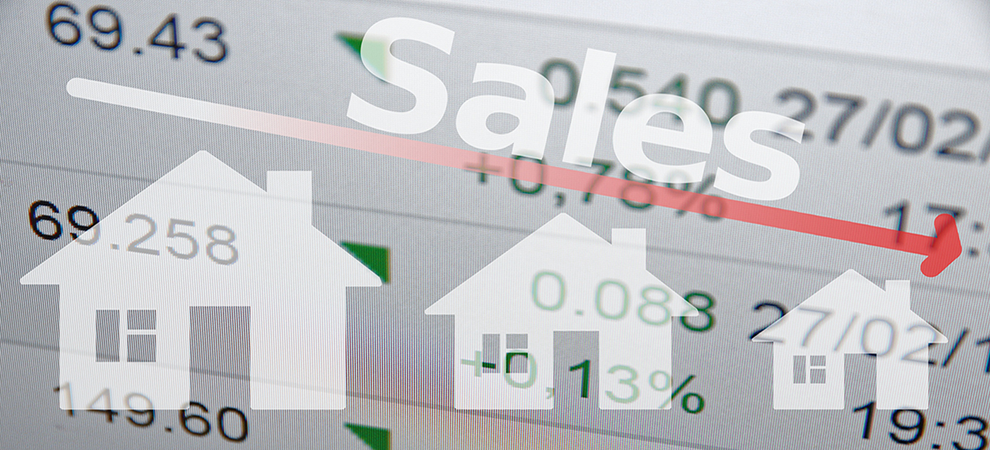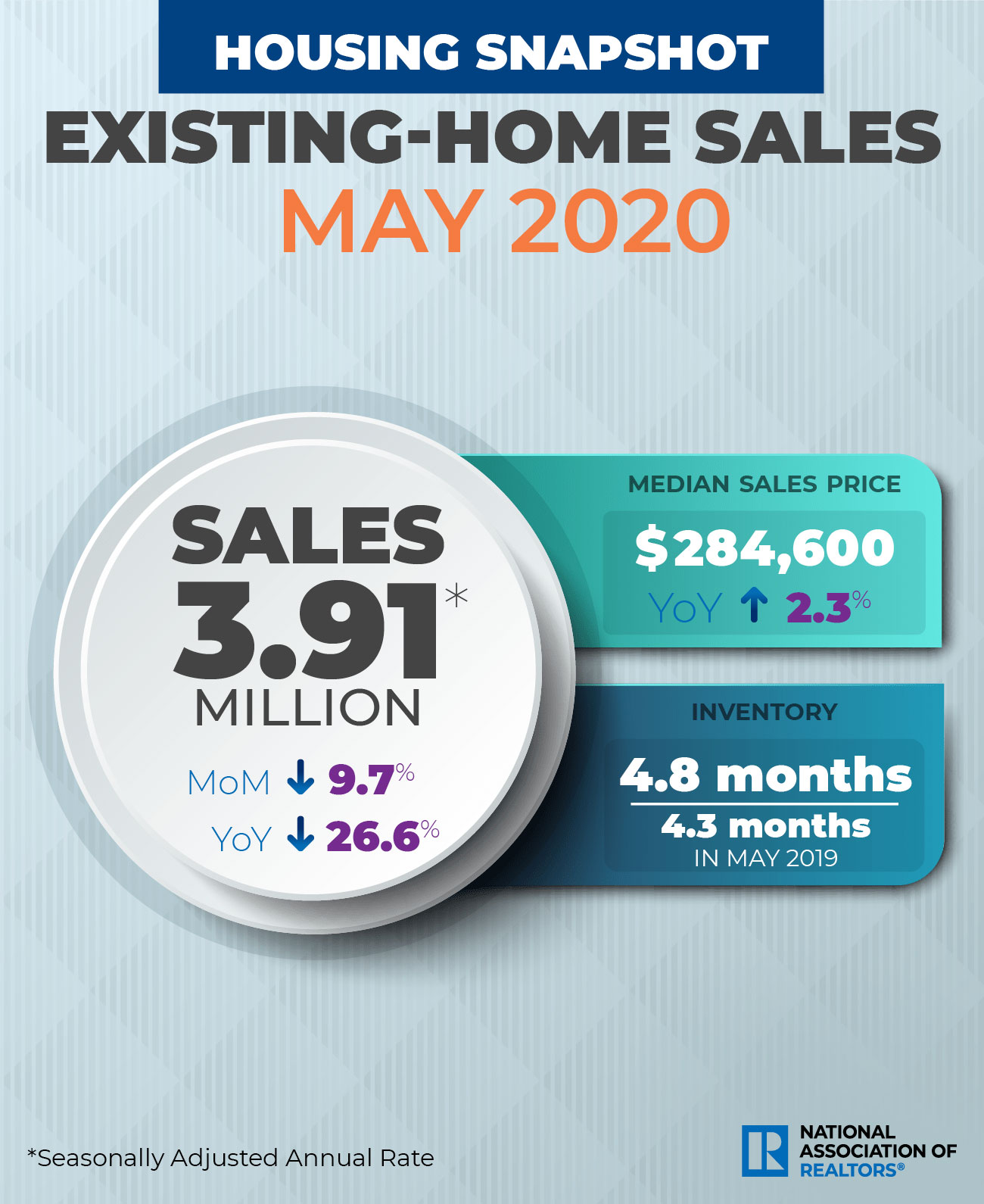The WPJ
THE WORLD PROPERTY JOURNALReal Estate Facts Not Fiction
Residential Real Estate News

NAR Reports U.S. Home Sales Slide 9.7 Percent in May
Residential News » Washington D.C. Edition | By Michael Gerrity | June 22, 2020 10:35 AM ET
According to the National Association of Realtors, existing-home in the U.S. sales fell in May 2020, marking a three-month decline in sales as a result of the coronavirus outbreak. Each of the four major regions witnessed dips in month-over-month and year-over-year sales, with the Northeast experiencing the greatest month-over-month drop.
Total existing-home sales, completed transactions that include single-family homes, townhomes, condominiums and co-ops, slumped 9.7% from April to a seasonally-adjusted annual rate of 3.91 million in May. Overall, sales fell year-over-year, down 26.6% from a year ago (5.33 million in May 2019).

Lawrence Yun
The median existing-home price for all housing types in May was $284,600, up 2.3% from May 2019 ($278,200), as prices increased in every region. May's national price increase marks 99 straight months of year-over-year gains.
Total housing inventory at the end of May totaled 1.55 million units, up 6.2% from April, and down 18.8% from one year ago (1.91 million). Unsold inventory sits at a 4.8-month supply at the current sales pace, up from 4.0 months in April and up from the 4.3-month figure recorded in May 2019.
"New home construction needs to robustly ramp up in order to meet rising housing demand," Yun said. "Otherwise, home prices will rise too fast and hinder first-time buyers, even at a time of record-low mortgage rates."
Properties typically remained on the market for 26 days in May, seasonally down from 27 days in April, but equal to 26 days in May 2019. Fifty-eight percent of homes sold in May 2020 were on the market for less than a month.
First-time buyers were responsible for 34% of sales in May, down from 36% in April 2020 and up from 32% in May 2019. NAR's 2019 Profile of Home Buyers and Sellers - released in late 2019 - revealed that the annual share of first-time buyers was 33%.
Individual investors or second-home buyers, who account for many cash sales, purchased 14% of homes in May, up from 10% in April 2020 and from 13% in May 2019. All-cash sales accounted for 17% of transactions in May, up from 15% in April 2020 and down from 19% in May 2019.
Distressed sales - foreclosures and short sales - represented 3% of sales in May, about even with April but up from 2% in May 2019.
"Although the real estate industry faced some very challenging circumstances over the last several months, we're seeing signs of improvement and growth, and I'm hopeful the worst is behind us," said NAR President Vince Malta. "NAR, along with our partners and 1.4 million members, are already working to reignite America's real estate industry, which will be a key driver in our nation's economic recovery."
According to Freddie Mac, the average commitment rate for a 30-year, conventional, fixed-rate mortgage decreased to 3.23% in May, down from 3.31% in April. The average commitment rate across all of 2019 was 3.94%.
Single-family and Condo/Co-op Sales
Single-family home sales sat at a seasonally-adjusted annual rate of 3.57 million in May, down 9.4% from 3.94 million in April, and down 24.8% from one year ago. The median existing single-family home price was $287,700 in May, up 2.4% from May 2019.
Existing condominium and co-op sales were recorded at a seasonally adjusted annual rate of 340,000 units in May, down 12.8% from April and down 41.4% from a year ago. The median existing condo price was $252,300 in May, a decrease of 1.6% from a year ago.
"Relatively better performance of single-family homes in relation to multifamily condominium properties clearly suggest migration from the city centers to the suburbs," Yun said. "After witnessing several consecutive years of urban revival, the new trend looks to be in the suburbs as more companies allow greater flexibility to work from home."
This relocating trend can be examined further in the buying behaviors of millennials, outlined in a recent NAR report identifying the top 10 markets with opportunities for millennial homebuyers. Among other factors, the report analyzes current housing affordability and job market conditions for millennials during the pandemic. The markets - listed in alphabetical order - are Austin-Round Rock, Texas; Dallas-Fort Worth-Arlington, Texas; Des Moines-West Des Moines, Iowa; Durham-Chapel Hill-Raleigh, N.C.; Houston-The Woodlands, Texas; Indianapolis-Carmel-Anderson, Ind.; Omaha, Nebraska/Council Bluffs, Iowa; Phoenix-Mesa-Scottsdale, Ariz.; Portland, Oregon/Vancouver, Wash.; and Salt Lake City, Utah.
Regional Breakdown
As was the case for the month prior, sales for May decreased in every region from the previous month's levels. Median home prices grew in three of the four major regions from one year ago, falling marginally in the West.
May 2020 existing-home sales in the Northeast fell 13.0%, recording an annual rate of 470,000, a 29.9% decrease from a year ago. The median price in the Northeast was $327,900, up 7.8% from May 2019.
Existing-home sales decreased 10.0% in the Midwest to an annual rate of 990,000 in May, down 20.2% from a year ago. The median price in the Midwest was $227,400, a 3.0% increase from May 2019.
Existing-home sales in the South dropped 8.0% to an annual rate of 1.73 million in May, down 25.1% from the same time one year ago. The median price in the South was $247,400, a 2.1% increase from a year ago.
Existing-home sales in the West fell 11.1% to an annual rate of 720,000 in May, a 35.1% decline from a year ago. The median price in the West was $408,400, down 0.2% from May 2019.
The Mortgage Bankers Association Chief Economist Mike Fratantoni also commented on NAR's numbers today by saying, "The most noteworthy data point in the May existing-home sales report was that existing housing supply last month was down almost 19% compared to a year ago. As buyers are returning to the market, as evidenced by the strong, nine-week rebound in MBA's purchase application data, the lack of homes for sale will be a real constraint. Although demand certainly dropped in March and April due to the crisis, supply dropped even more, and has thus far kept home prices from declining. We expect that home-price growth will pick up over the summer due to insufficient supply levels.
"The market is supported by strong demand from first-time homebuyers, who represented 34% of home purchases in May. Millennial-driven demand will be a tailwind for the market for the next several years."
Sign Up Free | The WPJ Weekly Newsletter
Relevant real estate news.
Actionable market intelligence.
Right to your inbox every week.
Real Estate Listings Showcase
Related News Stories
Residential Real Estate Headlines
- Las Vegas Area Home Prices Uptick 4.3 Percent Annually in March
- Single-Family Rent Growth in U.S. Trends Upward in 2025
- U.S. Mortgage Rates Tick Down Post Trump Tariffs Commencement
- President Trump's 'Liberation Day' Tariffs Potential Impact on the U.S. Housing and Mortgage Markets
- Baby Boomers Biggest Cohort of U.S. Home Buyers in 2025 as Millennials Decline
- U.S. Monthly Housing Payments Hit Record High in 2025
- U.S. Pending Home Sales Uptick in February
- Global Prime Residential Rent Slowdown Continued in Late 2024
- Ireland Home Price Inflation Hits 8 Year High in Early 2025
- Existing Home Sales in America Uptick in February
- Great Miami Area Residential Sales Decline 15 Percent Annually in February
- Mortgage Rates Uptick in Mid-March, Ending 9-Week Decline in U.S.
- World Property Ventures Builds the Future of Real Estate with New Funding Round
- U.S. Builder Sentiment Declines Amid Economic Uncertainty and Rising Costs
- Black Homeownership Rates in U.S. Enjoy Largest Annual Increase of All Racial Groups
- Wealthy Renters Are Taking Over More of the U.S. Rental Market
- If U.S. Congress Does Not Extend NFIP Soon, Thousands of Daily Home Closings Impacted
- U.S. Mortgage Applications Spike 11 Percent in Early March
- Greater Palm Beach Area Residential Sales Rise in Early 2025
- New Apartments in U.S. Are Leasing at Slowest Pace on Record
- U.S. Mortgage Rates Drop to 4 Month Low in March
- Overall U.S. Mortgage Delinquency Rates Dip in December
- New Tariffs on Canada, Mexico to Impact U.S. Homebuilder Input Costs
- Monaco's Property Market: A Tale of Two Cities
- U.S. Home Purchase Cancellations Surge, 1 in 7 Sales Getting Canceled
- U.S. Pending Home Sales Hit Historic Low in Early 2025
- Greater Miami Area Residential Sales Dip in January
- Governor DeSantis Supports Ending Property Taxes in Florida
- WPV Aims to Become the Berkshire Hathaway of Real Estate Tech
- U.S. Home Sales Slump Continues in January
- Average Americans Spend 38 Percent of Monthly Income on Mortgage Payments
- Switzerland's Safe-Haven Appeal Grows with World's Wealthy Homebuyers
- U.S. Builder Confidence Rapidly Declines in February
- Las Vegas Home Sales Rise 6.7 Percent Annually in January, Condo Sales Dip
- Homebuyer Demand in America Drops to 5-Year Low in Early 2025
- Ownership More Affordable Than Renting in Most U.S. Markets
- The World's First Global Listings Service Launches, Called a GLS
- Home Prices Continue to Rise in 89 Percent of U.S. Metros in Late 2024
- Global Luxury Residential Prices Showed Gradual Improvement in Late 2024
- U.S. Construction Hiring Rate Drops to Lowest Levels in 5 Years
Reader Poll
Marketplace Links
This website uses cookies to improve user experience. By using our website you consent in accordance with our Cookie Policy. Read More






